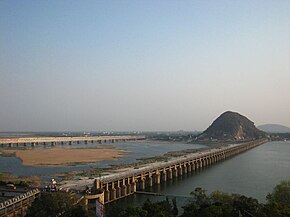 The River Krishna, meaning "dark" (feminine) in Sanskrit, also called the Krishnaveni is one of the longest rivers of India, which is about 1300 km in length.Krishna River originates in the Western Ghats at an altitude of about 1300 above sea level in Mahabaleshwar, about passes through Sangli and conjoins the sea in the Bay of Bengal at Hamasaledevi in Andra Pradesh. It flows through the states of maharashtra, Karnataka and Andra Pradesh. Most part of this river basin comprises undulating country except the western border which is formed by an unbroken line of ranges of the Western Ghats. The important soil types found in the basin are black soils, red soils, laterite and lateritic soils, alluvium, mixed soils, red and black soils and saline and alkaline soils. The delta of the river is one the most fertile regions in Bharat and was the home to ancient Satavahana and Ikshvaku sun dynasty, kings. Vijayawada is the largest city on the River Krishna.
The River Krishna, meaning "dark" (feminine) in Sanskrit, also called the Krishnaveni is one of the longest rivers of India, which is about 1300 km in length.Krishna River originates in the Western Ghats at an altitude of about 1300 above sea level in Mahabaleshwar, about passes through Sangli and conjoins the sea in the Bay of Bengal at Hamasaledevi in Andra Pradesh. It flows through the states of maharashtra, Karnataka and Andra Pradesh. Most part of this river basin comprises undulating country except the western border which is formed by an unbroken line of ranges of the Western Ghats. The important soil types found in the basin are black soils, red soils, laterite and lateritic soils, alluvium, mixed soils, red and black soils and saline and alkaline soils. The delta of the river is one the most fertile regions in Bharat and was the home to ancient Satavahana and Ikshvaku sun dynasty, kings. Vijayawada is the largest city on the River Krishna.
The traditional source of the river is a spout from the mouth of a statue of a cow in the ancient temple of Mahadev in Mahabaleshwar. According to a legend, it is considered that the Krishna River is Lord Vishnu himself as a result of a curse on the trimurtis by Savitri. Also, its tributaries Venna and Koyana are said to be Shiva and Brahma themselves. An interesting thing to notice is that 4 other rivers, viz: Koyana, Venna, Savitri and Gayatri, come out from the bull`s mouth apart from Krishna and they all travel some distance before merging into Krishna. The Krishna River sometimes gets disastrous in the monsoon seasons. Flowing fast and furiously, the Krishna River causes a high degree of erosion between June and August, often reaching depths of over 75 feet. It`s most important tributary is the Tungabhadra River, which is itself formed by the Tunga River and Bhadra River that originate in the Western Ghats. Other tributaries include the Koyna, Bhima, Kundali, Malaprabha, Ghataprabha, Yerla, Warna, Dindi, Musi and the Dudhganga River.
The rivers Koyna River, Vasna, Panchganga, Dudhganga, Ghataprabha River, Malaprabha River and Tungabhadra River join Krishna from the right bank; while the Yerla River, Musi River, Maneru and Bhima rivers join the Krishna from the left bank. (Image: Sangameshwar temple at river Krishna)There are many dams have been constructed on the river.Temples like Dattadeva temple, which is very dear to the people of Maharashtra is localed on the banks of Krishna at Narasoba Waadi. Also, Sangameshwar Shiva Temple at Haripur and Ramling Temple are located on the banks of river Krishna near Sangli.
Popular pilgrim spots like Audumber and Narsobawadi are located on the banks of river Krishna near Sangli in Maharashtra state. More pilgrim spots can be explored, especially that of Srisailam, one of the twelve jyotirlingas which also has a shrine for one of the shaktipeethasis on the river. Three tributaries meet Krishna River near Sangli. Warana River meets Krishna River near Sangli at Haripur.  This spot is also known as Sangameshwar (Image of Snagameshwar). Panchaganga River meets Krishna River at Narsobawadi near Sangli. These places are considered among the most sacred in Hindu mythology. It is said that Lord Dattatraya spent some of his days at Audumber on the banks of river Krishna.
This spot is also known as Sangameshwar (Image of Snagameshwar). Panchaganga River meets Krishna River at Narsobawadi near Sangli. These places are considered among the most sacred in Hindu mythology. It is said that Lord Dattatraya spent some of his days at Audumber on the banks of river Krishna.
Ecologically, this is one of the disastrous rivers in the world, in that it causes heavy soil erosion during the monsoon season. It flows fast and furious, often reaching depths of over 75 feet (23 m). Ironically, there is a saying in Marathi "sunt vaahate Krishnamaai" which means "quiet flows Krishna". This term is also used to describe how a person should be, as quiet as Krishna. But, in reality, Krishna causes a high degree of erosion between June and August. During this time, Krishna takes fertile soil from Maharashtra, Karnataka and western Andhra Pradesh towards the delta region.
